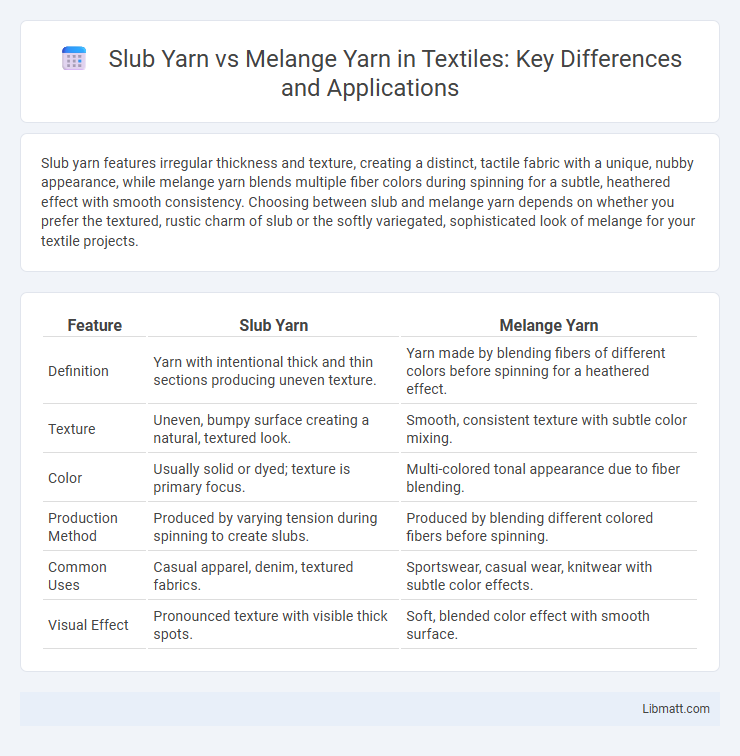Slub yarn features irregular thickness and texture, creating a distinct, tactile fabric with a unique, nubby appearance, while melange yarn blends multiple fiber colors during spinning for a subtle, heathered effect with smooth consistency. Choosing between slub and melange yarn depends on whether you prefer the textured, rustic charm of slub or the softly variegated, sophisticated look of melange for your textile projects.
Table of Comparison
| Feature | Slub Yarn | Melange Yarn |
|---|---|---|
| Definition | Yarn with intentional thick and thin sections producing uneven texture. | Yarn made by blending fibers of different colors before spinning for a heathered effect. |
| Texture | Uneven, bumpy surface creating a natural, textured look. | Smooth, consistent texture with subtle color mixing. |
| Color | Usually solid or dyed; texture is primary focus. | Multi-colored tonal appearance due to fiber blending. |
| Production Method | Produced by varying tension during spinning to create slubs. | Produced by blending different colored fibers before spinning. |
| Common Uses | Casual apparel, denim, textured fabrics. | Sportswear, casual wear, knitwear with subtle color effects. |
| Visual Effect | Pronounced texture with visible thick spots. | Soft, blended color effect with smooth surface. |
Introduction to Slub Yarn and Mélange Yarn
Slub yarn features intentional thick and thin sections, creating a textured fabric with unique irregularities that enhance visual interest and tactile appeal in your garments. Melange yarn blends fibers of different colors, producing a soft, heathered effect that offers subtle depth and a rich, multi-tonal appearance. Understanding these yarn types helps you select the perfect fabric for stylish, distinctive textile projects.
Defining Slub Yarn: Characteristics and Production
Slub yarn features deliberate, irregular thick and thin sections created by varying the tension during spinning, producing a textured and organic appearance ideal for adding visual interest to fabrics. It is made from continuous fibers with uneven thickness, resulting in a tactile surface often used in casual or rustic textile designs. Your choice of slub yarn can enhance fabric uniqueness with its characteristic slubs that create depth and dimension.
What is Mélange Yarn? Features and Manufacturing
Melange yarn is a type of yarn made by blending fibers of different colors before spinning, creating a unique, heathered effect with subtle color variations. Key features include enhanced visual texture, depth, and color complexity, often used in fashion textiles to achieve a soft, multi-tonal appearance. The manufacturing process involves mixing different colored fibers in precise ratios, carding them together, and spinning the blend into yarn, ensuring a consistent distribution of colors throughout the material.
Key Differences Between Slub Yarn and Mélange Yarn
Slub yarn features intentional thick and thin variations in its fiber thickness, creating a textured, uneven appearance ideal for casual and organic fabric looks. Melange yarn is produced by blending fibers of different colors before spinning, resulting in a subtle, heathered effect that adds depth and richness to the fabric's color. The primary difference lies in texture versus color variation: slub yarn emphasizes tactile irregularity, while melange yarn focuses on multi-tone color blending.
Appearance and Texture Comparison
Slub yarn features irregular thick and thin sections, creating a textured, uneven surface with a distinctive, handcrafted appearance, while melange yarn combines multiple colored fibers twisted together, resulting in a smooth fabric with a soft, blended color effect. Slub yarn's texture often gives your fabric a rustic, organic look, ideal for casual, artisanal styles. Melange yarn provides a subtle visual depth and a uniform feel, perfect for sleek, modern garments.
Performance and Fabric Properties
Slub yarn features irregular thicknesses that create a textured, tactile fabric with enhanced visual interest and natural breathability, making it ideal for casual, lightweight garments. Melange yarn, produced by blending different fibers or colors before spinning, offers consistent color variation and improved fabric durability, providing better strength and resistance to wear. Your choice between slub and melange yarn affects the garment's aesthetic appeal and performance characteristics, such as softness, durability, and moisture management.
Popular Applications in Textile Industry
Slub yarn is widely used in the production of denim, casual wear, and home textiles due to its unique texture and natural, uneven appearance that adds depth to fabrics. Melange yarn finds popularity in sportswear, knitwear, and fashion garments, prized for its blended fibers that create subtle color variations and a soft, heathered look. Both yarn types enhance aesthetic appeal and fabric performance in their respective applications within the textile industry.
Sustainability and Environmental Impact
Slub yarn, characterized by its irregular thick and thin sections, often uses natural fibers that require less processing, reducing water and chemical consumption. Melange yarn blends different colored fibers before spinning, enabling vibrant textiles without additional dyeing, which significantly lowers water pollution and energy use. Both yarn types contribute to sustainability, but melange yarn excels in minimizing environmental impact through efficient color integration and resource conservation.
Cost Considerations and Market Trends
Slub yarn typically incurs higher production costs due to its irregular texture and complex spinning process, making it a premium choice in niche fashion markets. Melange yarn, produced by blending fibers of different colors before spinning, offers cost efficiency and widespread use in casual and sportswear due to its consistent appearance and softer texture. Market trends indicate growing demand for melange yarn in sustainable and eco-friendly fashion lines, while slub yarn maintains a steady appeal in artisanal and high-end designer segments.
Choosing the Right Yarn: Slub vs. Mélange
Slub yarn features irregular thick and thin sections, giving your fabric a textured, vintage look, while melange yarn blends different colored fibers to create a subtle, heathered effect with smooth consistency. Choosing the right yarn depends on your project's aesthetic and performance needs: slub yarn suits casual, rustic styles with visual interest, and melange yarn excels in soft, color-rich garments with uniform texture. Your decision should balance desired fabric appearance, tactile feel, and the garment's wearability.
Slub yarn vs Mélange yarn Infographic

 libmatt.com
libmatt.com